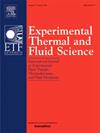Recarbonation of large dolomite particles for Calcium Looping
IF 2.8
2区 工程技术
Q2 ENGINEERING, MECHANICAL
Experimental Thermal and Fluid Science
Pub Date : 2024-12-15
DOI:10.1016/j.expthermflusci.2024.111392
引用次数: 0
Abstract
In order to enhance the energy efficiency of the calcium looping process for CO capture more energy efficient, a novel pressure-swing process has been developed. This process enables the utilization of the heat of reaction from the exothermic recarbonation for the endothermic calcination. The use of a packed bed allows the regeneration of reaction heat and requires the use of cm-size sorbent particles. On that scale, the recarbonation reaction has hardly been investigated so far. Therefore, recarbonation experiments utilizing a CO rich reaction gas mixture at atmospheric pressure are carried out in a continuously flushed electrical kiln, which is connected to a thermogravimetric system. Bulk and surface temperature are measured in order to account for limitations through equilibrium and to gain insight into the time-dependent heat transfer in the particle. Burnt natural dolomite is used as sorbent. The reaction rate is found to be a linear function of the conversion, with parameters depending on the kiln temperature as well as the gas velocity and the calcination degree of the sample. This linearity is observed for the entire reaction time and using two very different initial conditions with steady and unsteady boundaries. The results provide insights into the macroscopic dynamics of the recarbonation reaction in terms of temperature and conversion, and can therefore be used for model development and validation.
求助全文
约1分钟内获得全文
求助全文
来源期刊

Experimental Thermal and Fluid Science
工程技术-工程:机械
CiteScore
6.70
自引率
3.10%
发文量
159
审稿时长
34 days
期刊介绍:
Experimental Thermal and Fluid Science provides a forum for research emphasizing experimental work that enhances fundamental understanding of heat transfer, thermodynamics, and fluid mechanics. In addition to the principal areas of research, the journal covers research results in related fields, including combined heat and mass transfer, flows with phase transition, micro- and nano-scale systems, multiphase flow, combustion, radiative transfer, porous media, cryogenics, turbulence, and novel experimental techniques.
 求助内容:
求助内容: 应助结果提醒方式:
应助结果提醒方式:


